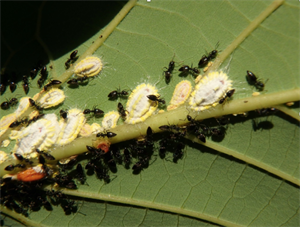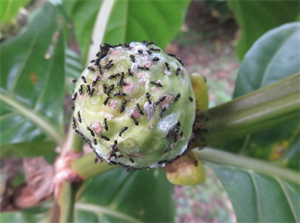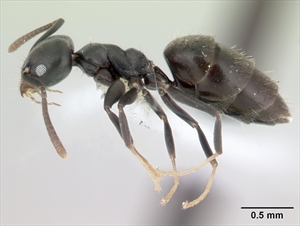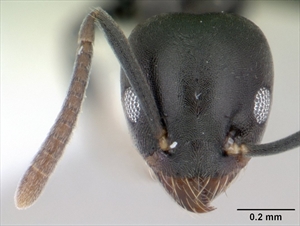- Worldwide distribution. In Australia, Cook Islands, Federated States of Micronesia, Fiji, Guam, Marshall Islands, New Caledonia, New Zealand, Niue, Palau, Papua New Guinea, Pitcairn, Samoa, Solomon Islands, Tokelau, Wallis and Futuna. Three similar white-footed species, needing specialist identification. Common in Pacific island countries.
- Major pest. Damage to plants indirect: protects natural enemies from attacking aphids, mealybugs, scales, whiteflies, encouraging outbreaks. Nests of debris on ground, in trees, in houses. Does not bite humans.
- Males, winged and wingless; three kinds females (queens, workers, 'intercastes'). Queens mate, establish colony; later, reproductive (fertilised) intercastes later take over. Foraging by (unfertilised) workers - living/dead insects, honeydew, own eggs.
- Tramp ant; spread by 'budding' - intercastes leave nest with workers, males and brood; spread with international trade.
- Biosecurity: requires risk assessments, regulations preventing introduction, protocols in case of breaches, and ability to make rapid response. Pacific Ant Prevention Plan available (IUCN/SSC Invasive Specialist Group).
- Cultural control: hot water at 47°C kills ants; over 49°C kills plants.
- Chemical control: use (i) stomach poisons (fibronil, Amdro®, borax), (ii) growth regulators (methoprene, pyriproxyfen), (iii) nerve poisons (bifenthrin, fipronil, imidacloprid). See (http://piat.org.nz/index.php?page=getting-rid-of-ants).
Pacific Pests, Pathogens and Weeds - Online edition
Pacific Pests, Pathogens, Weeds & Pesticides
White-footed ant - Technomyrmex albipes (360)
White-footed ant; white-footed house ant.
Technomyrmex albipes. Identification of the ant requires expert examination as there are several other species that are similar. Many specimens previously identified as Technomyrmex albipes have subsequently been reidentified as Technomyrmex difficilis (difficult white-footed ant) or as Technomyrmex vitiensis (Fijian white-footed ant), which also occurs worldwide.
AUTHOR Grahame Jackson
Information from Technomyrmex albipes. Wikipedia. (https://en.wikipedia.org/wiki/Technomyrmex_albipes); and Technomyrmex difficilis (=albipes) Entomology & Nematology. UF/IFAS, University of Florida (http://entnemdept.ufl.edu/creatures/urban/ants/white-footed_ant.htm); and Pacific Invasive Ant Toolkit. White-footed ants. (http://www.piat.org.nz/index.php?page=white-footed-ants); and Technomyrmex albipes. AntWiki. (http://www.antwiki.org/wiki/Technomyrmex_albipes); and from Technomyrmex albipes (2018) Global Invasive Species Database. (http://www.iucngisd.org/gisd/speciesname/Technomyrmex+albipes). Photos 1&2 Randolf Thaman, University of the South Pacific, Fiji. Photos 3-5 April Nobile from Antweb. (https://www.antweb.org/bigPicture.do?name=casent0178469&number=1&shot=p).
Produced with support from the Australian Centre for International Agricultural Research under project HORT/2016/185: Responding to emerging pest and disease threats to horticulture in the Pacific islands, implemented by the University of Queensland and the Secretariat of the Pacific Community.








